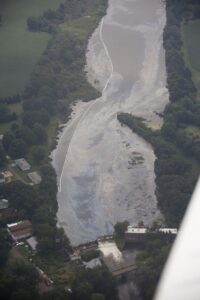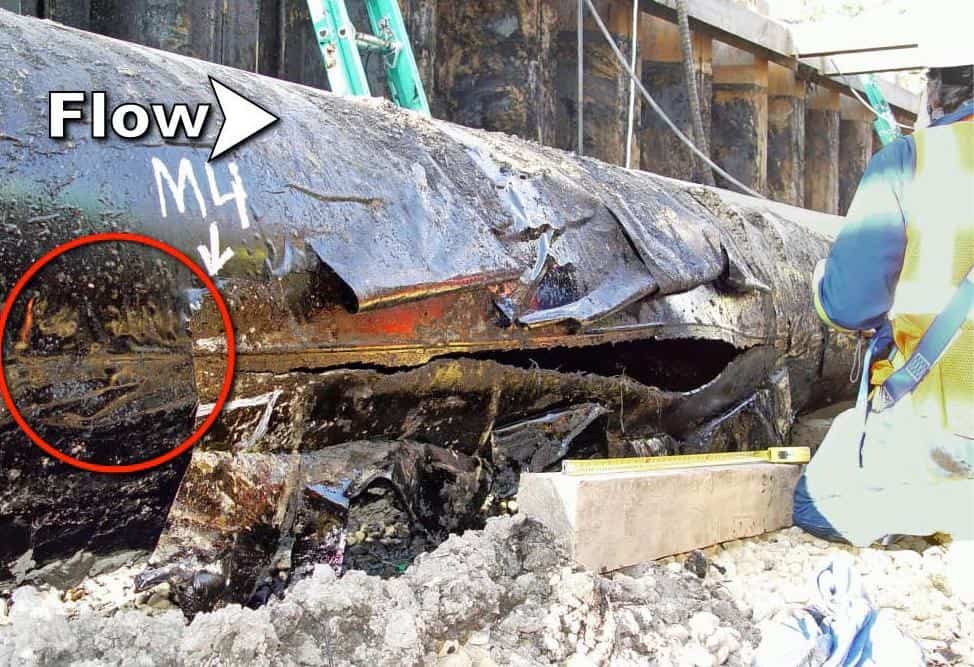July 25th, 2010, Line 6B pipeline near Marshall, Michigan, burst, causing one of the largest inland oil spills in U.S. history. The pipeline ruptured due to cracks in the aging infrastructure, exacerbated by external corrosion. Inadequate inspection and maintenance procedures were the most significant factors causing the failure.
Every oil spill is a disaster, however, this escalated to horrific proportions when critical alarms indicating the rupture continued for hours. Although the Line 6B rupture triggered alarms, the operating company failed to recognize a pipeline had ruptured until at least 17 hours later. In the meantime, they restarted Line 6B twice, pumping additional oil into the ruptured pipeline and discharging it into the environment.
Ultimately, Line 6B discharged at least 20,082 barrels of crude oil, much of which entered Talmadge Creek and flowed into the Kalamazoo River upstream of Lake Michigan. Flooding caused by heavy rains pushed the discharged oil over the river’s banks into its flood plains and accelerated its migration over 35 miles downstream before it was contained.
The Department of Justice and the U.S. Environmental Protection Agency investigation resulted in civil penalties totaling $62 million for Clean Water Act violations. The total cost of penalties and clean up is now thought to be about $120 million. It also prompted extensive requirements to prevent spills and enhance leak detection capabilities throughout the Lakehead pipeline system – a network of 14 pipelines spanning nearly 2,000 miles across seven states.
To their credit, the operating company followed through with one of the most comprehensive clean-up and compensation efforts seen in response to a pipeline failure. Details of their response can be found online.
Preventing such disasters requires robust pipeline integrity management systems. Regular inspections, proper maintenance, and adherence to safety regulations are essential.
The pipeline rupture could likely have been avoided if proper inspections had been conducted and the corrosion had been discovered and addressed promptly. The incident revealed significant shortcomings in the inspection and maintenance practices of the operating company. Regular and thorough inspections, including advanced technologies such as a modern, robust Computerized Maintenance Management System (CMMS), inline inspection tools (smart pigs), and external corrosion monitoring, could have detected the corrosion before it reached a critical point.
In the Oil & Gas industry, Azzier CMMS is being leveraged to mitigate the risk of critical infrastructure failure. Tero Consulting Ltd. has many Oil & Gas customers across the West and Midwest, as well as in the Gulf of Mexico. Tero is very proud of our work in this industry and there has never been an oil spill by any of our clients.
Finding a CMMS that has a robust Inspections Workflow is critical. WebWork Azzier has always had a comprehensive inspection workflow in our ‘Route Readings’ module. Version 8.0 takes this to a whole new level with enhanced workflows and the addition of a mobile application that genuinely empowers your inspectors.
To maintain regulatory compliance, CMMS is mandatory in most jurisdictions, minimizing the risk of another disaster like this. Web Work Azzier was the world’s first web-based CMMS and continues to be a leader in this space.
Visit our website and register for a FREE TRIAL. Try out Azzier 8.0; if it works for your company, convert your trial to a production site directly and easily through our website.
Take Azzier® for a test drive at https://azzier.com.
Call 1-866-818-8376 ext. 407 for a personalized consultation of your maintenance needs or email us at sales@tero.ca . With 44 years of maintenance experience, we can help you reduce risk and improve your bottom line.
Steven Eder, Director Sales and Marketing
Tero Consulting Ltd.




